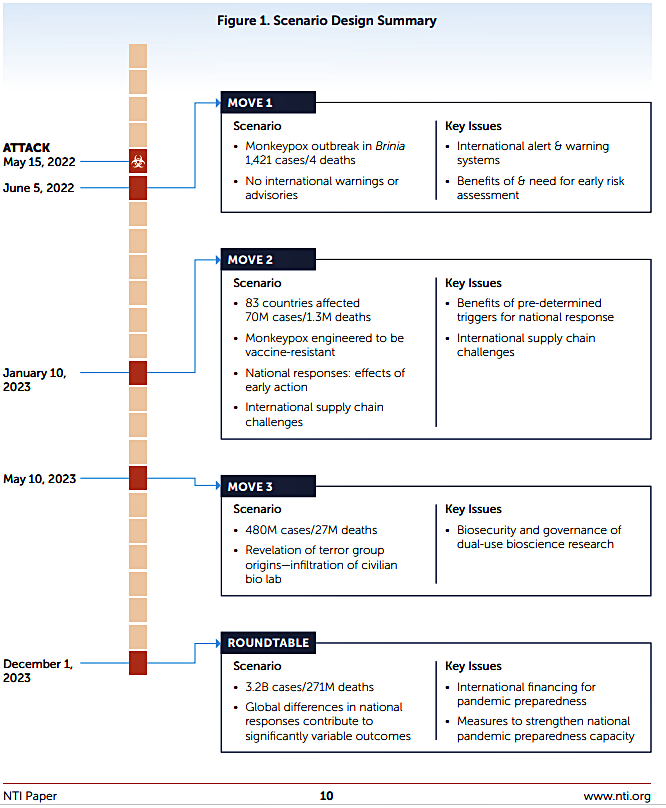In March, 2021, the “Nuclear Threat Initiative” Held a “Drill” for MonkeyPox Terror Attack
Move 1 (occurring on June 5, 2022, in scenario time) starts with an unusual outbreak of monkeypox in Brinia
(population 250 million), with reports of 1,421 cases and four fatalities. There is no immediate evidence of
international spread, but the outbreak takes place during a national holiday with extensive domestic and
international travel by Brinians. Because monkeypox is not naturally found in Brinia, local and international
experts consider this outbreak to be unusual. The Brinian government welcomes international outbreak
investigations and requests medical support from the WHO. Genome sequencing of monkeypox patient
samples reveals that the strain in Brinia contains mutations that make it resistant to existing vaccines.
The discussion that followed considered how the international system is postured to analyze initial indicators
of pandemic risk and to communicate appropriate warnings.
Move 2 (January 10, 2023) occurs six months later, at which point the virus has spread to 83 countries with
70 million reported cases, causing more than 1.3 million fatalities. With no known effective therapies or
vaccines, countries have had to rely principally on non-pharmaceutical interventions (NPIs) to mitigate the
impacts of the pandemic. Highlighting significantly different national outcomes in managing the pandemic,
some governments, including the fictional Republic of Dranma, promptly adopted aggressive measures
to slow virus transmission by shutting down mass gatherings, imposing social-distancing measures, and
implementing mask mandates. These countries have also established large-scale testing and contact-tracing
operations and scaled-up their health care systems to support anticipated growing case numbers. By
contrast, the scenario depicts another group of countries, including fictional Cardus, that have prioritized
keeping their economies open, undertaking little-to-no NPIs, and downplaying the virus and its potential
impacts. These countries have experienced much worse outcomes in terms of illness and mortality (Figure
2) than those that responded early and energetically. As Figure 3 shows, Dranma experienced far fewer
cases and fatalities than Cardus.
Participant discussion in Move 2 focused on exploring the conditions that should trigger national pandemic
response actions and discussing strategies and challenges for scaling public health interventions.
Figure 2. Cardus vs. Dranma: Cumulative Deaths
Number of Deaths
100,000,000
1,000,000
10,000
100
0
MOVE 1 MOVE 2
Jun 2022 Sep 2022 Dec 2022 Mar 2023 Jun 2023 Sep 2023 Dec 2023
Cardus Deaths Cardus Projected Deaths
Dranma Deaths Dranma Projected Deaths
NTI Paper 12 www.nti.org
Strengthening Global Systems to Prevent and Respond to High-Consequence Biological Threats
Move 3 (May 10, 2023) occurred 12 months after the initial outbreak, with more than 480 million cases and
27 million fatalities globally (Figure 4). At this stage, participants learn that the pandemic was caused by a
regional bio-terror attack that far exceeded the perpetrators’ goals.
Figure 3. Cardus vs. Dranma: Cumulative Cases
MOVE 1 MOVE 2
Number of Cases
100,000,000
1,000,000
10,000
100
0
Jun 2022 Sep 2022 Dec 2022 Mar 2023 Jun 2023 Sep 2023 Dec 2023
Cardus Cases Cardus Projected Cases
Dranma Cases Dranma Projected Cases
Figure 4. Global Cumulative Cases and Deaths
Number of People
3,500,000,000
3,000,000,000
2,500,000,000
2,000,000,000
1,500,000,000
1,000,000,000
500,000,000
0
Jun 2022 Sep 2022 Dec 2022 Mar 2023 Jun 2023 Sep 2023 Dec 2023
Global Cumulative Cases Total Deaths
MOVE 1 MOVE 2 MOVE 3 ROUNDTABLE
NTI Paper 13 www.nti.org
Strengthening Global Systems to Prevent and Respond to High-Consequence Biological Threats
Specifically, Brinian intelligence reveals that the engineered monkeypox virus was developed illicitly at
the fictional country of Arnica’s leading institute for virology. Arnica (population 75 million) has a history
of conflict with neighboring Brinia (see map in Figure 5). An independent Arnican terrorist group—the
SPA—had worked with sympathetic laboratory scientists to
engineer a highly contagious, deadly pathogen and disperse
it at crowded train stations in Brinia during the national
holiday, when much of the population was travelling
domestically and internationally.
The SPA had exploited the Arnican government’s weak
oversight of its bioscience research laboratories. SPA
sympathizers working in Arnica’s leading virology institute
used publicly available scientific publications to guide their
work to modify the monkeypox virus to make it more
transmissible and resistant to currently available vaccines.
The discussion in Move 3 focused on governance of dualuse bioscience research as well as current weaknesses in
biosafety and biosecurity systems that exacerbate biological
risks.
The final phase of the exercise was a roundtable discussion
that considered disparities in public health preparedness
around the globe and the resulting need for more effective
financing mechanisms to accelerate pandemic preparedness capacity building. Recognizing that pandemic
preparedness requires costly investments that lower- and lower-middle income countries cannot afford to
make, participants were asked to discuss strategies to catalyze these investments in sustainable ways.
BRINIA
ARNICA
Figure 5. Map of the Fictional
Country of Brinia, the Geographic
Origin of the Outbreak
NTI Paper 14 www.nti.org
Strengthening Global Systems to Prevent and Respond to High-C.
